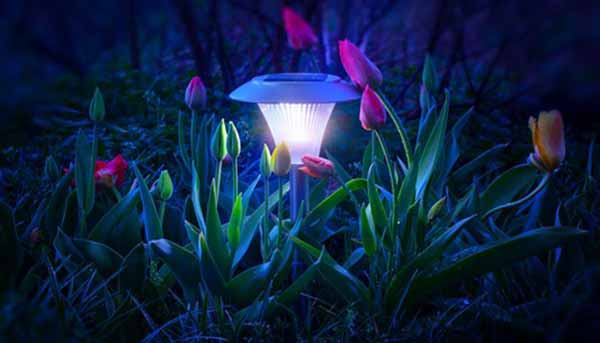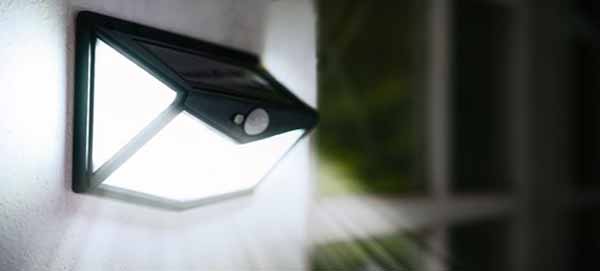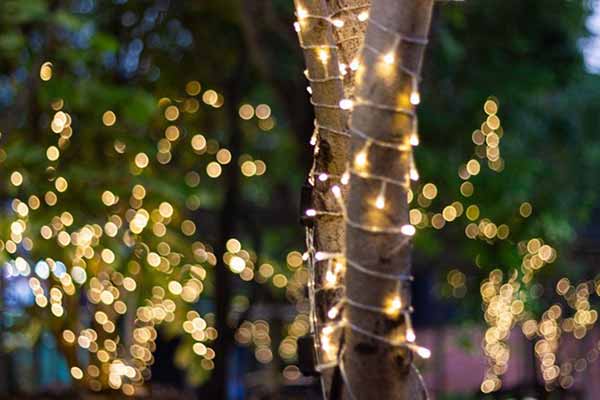Solar-powered outdoor lights are an easy-to-install and low-maintenance solution for a home’s outdoor spaces. You can illuminate everything from entryways to front doors to entire outdoor gardens with the free and renewable energy of the sun.
There are many solar-powered outdoor lights on the market, some aimed at improving your home’s ambiance, others at security. Let’s look at choosing not only the best solar-powered lights but also the most appropriate ones for your home and garden.
How Do Solar-Powered Outdoor Lights Work?
Solar-powered lights usually comprise LED bulbs for light, a solar panel to collect the sun’s energy, and a rechargeable battery or batteries to store that energy.
The solar panel converts the sun’s rays into chemical energy and stores it in the battery. The battery discharges the chemical energy when the light turns on, usually at night.
Buying Solar-Powered Outdoor Lights
There are several important factors to consider before buying your solar-powered lights. We’ll expand on each of these.
- Types of light: There’s everything from deck lights to sconces to bright walkway lights and floodlights. Think about the lighting’s purpose and placement.
- Battery: Type, charge, and running time, including different weather conditions.
- Brightness: Do you want a cool white to light up a driveway or yard, or warm white to create a cozy outdoor entertainment space?
- Durability: Strong sun or damp climates need sturdy equipment that will last.
- Activation: Will the lights be on all night? Or would you prefer remote or outdoor motion sensor-activated lighting?
- Ease of use: Installation, maintenance, and lifespan.
What Are the Benefits of Solar-Powered Outdoor Lights?
Solar-powered outdoor lights offer many benefits, not least that they save money on your energy bill. After your initial investment, there’s no more paying to illuminate your garden or yard, thanks to their eco-friendly use of the sun’s renewable energy!
For that reason, it can make sense to spend a little more on solar-powered lights because of the long-term energy savings. There are many more plusses, too.
Solar-powered lights come as a ready-made package with usually no wiring required. The only installation is for their placement. Installing can be very easy if placing decorative string lights, or a little more complicated if drilling and screws are needed to mount larger wall lights.
The choice of solar lights is bountiful. You can try them in several positions or even change them throughout the year to perfectly match your requirements. Placement and possibly replacing rechargeable batteries are the only maintenance that solar-powered lights require.
Many stores stock solar-powered lights. Browsing best-sellers can help you get a feel for the options.
What Are the Types of Solar-Powered Outdoor Lights?
As with any lighting, you must choose something appropriate to the space and your needs. Here are the principal types of solar-powered lights.
Solar garden lights can be anything from landscape spotlights illuminating a specific area, to solar path lights to light up pathways and garden beds. Landscape lights are moveable and help indicate the edge of swimming pools or light the path to dark corners of the garden.
Wall-mounted lights are perfect for patios, decking areas, steps, and yards. As the name suggests, wall-mounted lights fit exterior walls, fences, posts, or any suitable base. Wall-mounted lights can be sconces, lamp-post style, lanterns, and more.
Post lights are usually on top of posts on decks, while fence lights with warm light settings are ideal for marking your property’s boundary.
One of the most common uses of solar lights outdoors is as solar flood lights for security. Technological advances mean solar-powered LED lights create enough bright white to provide an effective deterrent. These solar spotlights can be permanently turned on or glow dimly and brightly when activated by motion sensors. Choose between wall-mounted or portable solar landscape lights so you can cover all your home’s outdoor space.
Solar has many decorative light possibilities too, from solar lanterns to flowers or fireflies in a jar. You can illuminate a path by dropping solar bricks or solar pavers onto tracks, or even into the walkway, creating solar pathway lights.
Solar string lights add a splash of playful fun to outdoor spaces. Many LED string lights change color or come in beautiful shapes, like butterflies. String lights are a simple and effective way to brighten up trees, fences, patios, and canopies.
What Light Bulbs Do Solar-Powered Lights Have?
Solar-powered lights use light-emitting diodes or LED light bulbs. These bulbs are highly energy-efficient and long-lasting, as well as versatile.
How Do I Choose the Brightness for Solar-Powered Lights?
All LED light bulbs, including those in solar-powered outdoor lights, get a rating in lumens. The higher the lumen rating, the brighter the light bulb. Lumen ratings are essential to creating the right ambiance in your garden. Your guests may not appreciate film-set standard white light while enjoying a meal on your deck.
However, you might want a high lumen rating for security spotlights and any outdoor LEDs used for guidance and direction. A low lumen level of 5-10 brings landscape ambiance, whereas anything over 350 lumens is an intense flood light or spotlight.
You need to check an LED light bulb’s Kelvin rating, too. Kelvin relates to a bulb’s color in terms of its warmth. The lower the Kelvin rating, the warmer the color.
- 2,000-3,000 Kelvin gives a warm color
- 3,100-4,500 Kelvin gives a natural white light
- 4,600 Kelvin and above gives cold blue-white light
What Battery Size Does My Solar-Powered Light Need?
Your solar light’s battery capacity directly affects how long it will provide illumination, making battery capacity a vital part of your purchase planning.
Batteries have mAh ratings to tell you the battery’s storage capacity. The higher the rating, the more energy your battery can store, and the longer it can keep light bulbs lit. Solar-power outdoor lights with many LEDs or powerful LEDs, like security lights, need high battery mAh ratings.
Batteries come with ‘C’ ratings, too. The C refers to capacity and means the maximum power, or current, that can be safely used or charged to and from a battery.
How Long Will My Solar-Powered Light Take to Charge?
A solar-powered light’s battery charge time depends on many factors. These include:
- Battery capacity
- Climate where you live
- Amount of direct sunlight the solar panel receives
Experts estimate it takes four to 10 hours to charge a solar-powered light fully. A solar panel will work at between 10-25% efficiency on cloudy days. Rain can be beneficial too, cleaning the panels of dust, dirt, and even bird droppings, which may impede performance.
Make sure all solar-powered outdoor lights receive unobstructed sunlight, particularly between 10 a.m. and 2 p.m., although timing is less important in very sunny climates.
People living in northern areas like Alaska may find solar-powered lights don’t charge well in winter. The U.S. Department of Energy estimates winter reduces charging effectiveness by 30-50%.
Enter your ZIP Code and compare electricity rates
How Long Will Solar-Powered Lights Shine?
There’s no point installing solar-powered security lights if they don’t turn on when required, right?
Many companies put a runtime or output time in hours on their products, so you know how long they’ll work with fully charged batteries. The average illumination time is around six to 10 hours from fully charged batteries, with a two- to five-year lifespan until you need to change the batteries. Other pointers to help you decide what best suits your needs include:
- Smaller batteries mean less operating time.
- Multiple batteries help prolong their lifetime.
- Be prepared to change rechargeable batteries every few years.
Pro tip: Buy a solar light from a company that puts a performance promise or warranty on its batteries.
Do I Need Waterproof Solar-Powered Outdoor Lights?
 source
source
Your solar lights’ durability is essential, especially if you live in a region with lots of rainfall or sunshine.
Waterproof and weather-resistant solar lights are vital to last through all four seasons because life outside can be tough. Check the lights’ materials; some are plastic, others stainless steel or other materials.
Fortunately, it’s simple to gauge any potential purchases for weatherproofing. Outdoor solar lights receive an Ingress Protection (IP) rating, which measures their ability to stop water, dust, snow, and wind from entering their internal workings.
The higher the IP, the more protection offered. There are two numbers to consider, and these may influence which light you buy, depending on the climate where you live.
The first number relates to solids, and its scale runs from 0 (no protection) to the highest protection of 6.
The second digit relates to liquids, and its scale also runs from 0 (no protection) to 8 for lights like underwater pool lights.
So an IP53 is not as waterproof as an IP46, but the IP 53 is better at keeping out dust. Most experts agree that an IP of 4 or more is preferable.
Is It Okay to Leave Solar Lights Out in the Winter?
Yes, you can leave solar lights out in the winter. They’ll charge on sunny days as long as the panels receive sun.
Solar lights won’t work if they’re covered with snow or if their solar panels are dirty. Solar lights and other garden furniture should be secured or stored safely in storms and high winds.
What Features Come With Solar-Powered Lights?
There are many features to consider for your solar-powered lights, from remote controls to motion sensor lights.
Do you want a security light that’s on all night or activates when its sensors detect movement? Some lights have brightness settings, some have solar panels that tilt so you can track the sun’s position, and others are made of sturdy metal frames instead of plastic.
There are timer-controlled lights and others that automatically illuminate from dusk to dawn. Lights on permanently will take more toll on the batteries installed, and dusk-to-dawn lights struggle to recharge in winter when days are short and nights long.
Others have lighting modes — check your model’s instructions before use — to have it bright for when the kids play outside, then softer for dinner parties.
Are Solar-Powered Lights Easy to Install?
Most solar-powered lights require some assembly with little more than a screwdriver, then placed in your garden, possibly using a stake. Some larger floodlights need mounting to a wall, fence, or post. Some lights can be attached to traditional light fixtures using screws.
Compare this to wiring an entire yard or garden to demanding electrical standards, and it’s easy to see why solar-powered outdoor lights are widespread.
Are Solar-Powered Lights Easy to Maintain?
Solar-powered lights are easy to maintain. Follow these tips to keep them in good working order:
- Regular checks to ensure the solar panel is clean and free of debris.
- Clean panels with soapy water, rinse thoroughly, and dry with a towel.
- Make sure panels receive direct sunlight.
- Check battery connections if the lights start working fewer hours. Replace the rechargeable batteries when they’re old.
Will Outdoor Solar-Powered Lights Save Money?
Outdoor solar-powered lights can save you money in the long run. There’s an initial outlay, especially if you choose high-powered solar lights with solid batteries. Still, there is a cost for any new outdoor lighting, solar or grid-based.
The true benefit of solar lights comes at the end of every month with your energy bill. Solar lights don’t use electricity from the grid, so they don’t add any dollars to your power expenses.
What Are Some Examples of Solar-Powered Outdoor Lights?
There are a vast number of solar-powered outdoor lights. Here are a few ideas to kick-start your search for what suits you best.
The TBI Solar Lights Outdoor Super-Bright lights are for people looking for very bright solar flood lights. They pack a 2,500-lumen output — one of the most potent home solar LED security lights available.
Solar security lights don’t always need to be big hitters. The InnoGear Solar Outdoor Lights are portable LED flood lights to help shine light on the most difficult to illuminate areas.
Aootek Solar Lights are one of the most affordable and popular motion-sensor security solar lights. People wanting a wider beam could look at the MITAOHOH solar lights with 270-degree light coverage. Our last solar flood light is the Aqonsie wall-mounted option, which looks like a solar street light. It features a remote control, pivoting lights, and three lighting modes.
For funky walkways with solar bricks, the frosted Kendal Solar Brick and the LampLust Textured Landscape Light are good starting points. The Lightsmax Pathway Light range would bring beauty to any garden.
Don’t have a green thumb? Fear not, the stunning Kooper flower garden lights will brighten up any space.
Why Solar-Powered Outdoor Lights Are Ideal
Solar-powered outdoor lights come in all shapes, sizes, and uses, with a panoply of beautiful designs and clever functions.
They make great security lights or beautiful adornments and help you create a personalized ambiance throughout your garden, yard, or outdoor space.
They require minimal fitting and maintenance and won’t cost you a dime on your energy bill. Switch your energy supplier to renewable energy, and you’ll be able to enjoy 24-hour clean energy every day of the year.
Brought to you by energysavings.com
All images licensed from Adobe Stock.
Featured image:




